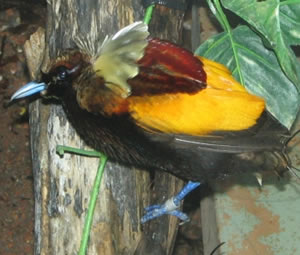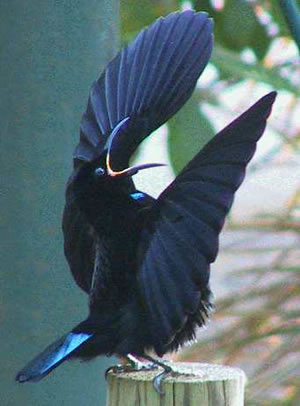The birds of paradise of northern Australia and Papua New Guinea are famous for their elaborate plumages.
The natives of New Guinea have long used the feathers of these birds in their headdresses, particularly the blue breast feathers of the blue birds and the golden rain of the greater bird's tail.
The bird of paradise is featured on the flag of Papua New Guinea.
These birds, which are related to crows and starlings, live in the canopy of the tropical rainforest.
 They are omnivorous, and eat fruits, fruits, insects and spiders.
They are omnivorous, and eat fruits, fruits, insects and spiders.
Birds of paradise have strong claws, which they use to tear into dead bark in search of food.
The only natural predators of birds of a paradise are a few reptiles, such as the Green tree python of Papua, New Guinea. Therefore, these birds do not need camouflage.
Instead, these birds have become nature's most flamboyant, capable of putting on stunning visual displays.
Only the male birds have the striking plumage for which the group is famed; the feathers of the females are dull. The displays of the males (for the benefit of the females) enhance the visibility of whichever part of their plumage is most exaggerated.
 Several species, such as the greater bird of paradise, king bird and blue bird, display by hanging upside-down underneath the branches; this enables them to show off to maximum advantage the underside of their wings and patches of breast feathers.
Several species, such as the greater bird of paradise, king bird and blue bird, display by hanging upside-down underneath the branches; this enables them to show off to maximum advantage the underside of their wings and patches of breast feathers.
Their vivid hues are produced by a combination of pigments, and structural modification of the feather barbules, which distort the reflection of light to give an iridescent sheen.
Reproduction
The female bird of paradise builds a well-constructed nest, usually of pandanus leaves and palm fronds, about 12 to 30 feet (4 to 10 m) above ground in a dense thicket. It is left unlined.
The female lays one to three eggs, which she incubates for up to about three weeks.
It is common for breeding between species to take place. Researchers have reported at least 19 hybrids, which appear to have come been produced because of one species being attracted to the displays of another.